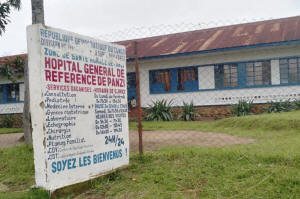Congo man dies with hemorrhagic fever, indicating mystery outbreak could
be more than just malaria
 Send a link to a friend
Send a link to a friend
 [December 20, 2024]
By MONIKA PRONCZUK [December 20, 2024]
By MONIKA PRONCZUK
DAKAR, Senegal (AP) — A man in western Congo died Thursday with
hemorrhagic fever symptoms, leading officials to suspect that a
still-unidentified virus may be involved alongside malaria in a
mysterious outbreak that has killed dozens of people, health authorities
said.
Congo authorities said last week that they suspected malaria in the
flu-like disease outbreak, which has killed at least 37 people and in
which more than four out of five patients have tested positive for
malaria.
But the death of the man with hemorrhagic fever — not normally
associated with parasite-caused malaria — could indicate a virus at work
as well.
The man died Thursday in the remote Panzi area of Kwango province where
the outbreak has been recorded, Africa Center for Disease Control and
Prevention official Ngashi Ngongo told reporters.
That has led to a working hypothesis that the outbreak is either “severe
malaria on a background of malnutrition” or “a viral infection that is
happening on the background of malaria," Ngongo said.
Malaria is endemic in the Panzi area, where there also are high levels
of malnutrition, complicating the diagnosis of the latest outbreak.

So far, there have been 592 reported cases and 37 deaths confirmed in
health facilities, Ngongo said. That is an increase of 65 cases and 5
deaths compared to last week. There have been an additional 44 deaths
documented in communities, which are currently being investigated.
Out of samples taken from 51 cases, 86% have tested positive for
malaria. Tests for additional diseases are being conducted at national
laboratories and are expected next week, Ngongo said.
[to top of second column]
|

A view of the Panzi general Hospital, in southwestern Congo,
Thursday, Nov 5, 2024. (AP Photo/Lucien Lufutu, File)
 The head of the World Health
Organization, Tedros Adhanom Ghebreyesus said last week that most of
the blood samples collected in the Panzi area were positive for
malaria but that it was possible that more than one disease was
involved. He said further samples were being collected and tested.
Most of the cases and deaths reported in Panzi have been children
under 14, according to WHO.
The symptoms have included fever, headache, cough and anemia.
Experts from WHO and Congo's National Rapid Response Team were in
the area last week to investigate and take samples.
The Panzi health zone, around 435 miles (700 kilometers) from the
capital, Kinshasa, is hard to access. The experts took two days to
arrive, according to Congo’s health minister.
Because of the lack of local testing capacity, samples had to be
taken to Kikwit, more than 310 miles (500 kilometers) away, the head
of the National Institute for Public Health, Dieudonne Mwamba, said
last week.
Panzi was hit by an epidemic of typhoid fever two years ago, and
there is currently a resurgence of seasonal flu across the country,
Mwamba added.
The area also has low vaccination coverage, leaving children
vulnerable to a range of diseases including malaria, the head of the
WHO said Tuesday.
All contents © copyright 2024 Associated Press. All rights reserved |